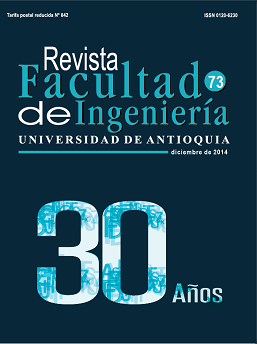On the implementation of adaptive multiresolution spectral WENO scheme for the multiclass Lighthill-Whitham-Richards traffic model
DOI:
https://doi.org/10.17533/udea.redin.17574Keywords:
Lighthill-Whitham-Richards kinematic traffic model, WENO schemes, conservation laws, adaptive multiresolutionAbstract
In this paper, the implementation of a spectral or characteristic-based fifth order WENO (Weighted Essentially Non-Oscillatory) scheme is described in detail along with an adaptive multiresolution technique for efficiently computing the numerical solution of a multi-class traffic flow model described mathematically by a nonlinear system of conservation laws. In [1] the authors considered the same problem but in a component-wise manner. More recently, [2] conducted numerical experiments by using characteristic-based schemes combined with AMR (Adaptive Mesh Refinement) strategy.
Downloads
References
R. Bürger, A. Kozakevicius. “Adaptive multiresolution WENO schemes for multispecies kinematic flow models”. J. Comput. Phys. Vol. 224. 2007. pp. 1190- 1222. DOI: https://doi.org/10.1016/j.jcp.2006.11.010
R. Donat, P. Mulet. “Characteristic-based schemes for multi-class Lighthill-Whitham-Richards traffic models”. J. Sci. Comput. Vol. 37. 2008. pp. 233-250. DOI: https://doi.org/10.1007/s10915-008-9209-5
A. Harten. “Multiresolution algorithms for the numerical solution of hyperbolic conservation laws”. Comm. Pure Appl. Math. Vol. 48. 1995. pp. 1305- 1342. DOI: https://doi.org/10.1002/cpa.3160481201
S. Benzoni, R. Colombo. “An n-populations model for traffic flow”. Eur. J. Appl. Math. Vol. 14. 2003. pp. 587-612. DOI: https://doi.org/10.1017/S0956792503005266
G. Wong, S. Wong. “A multi-class traffic flow model - an extension of LWR model with heterogeneous drivers”. Transp. Res. A. Vol. 36. 2002. pp. 827-841. DOI: https://doi.org/10.1016/S0965-8564(01)00042-8
P. Zhang, R. Liu, S. Wong, S. Dai. “Hyperbolicity and kinematic waves of a class of multi-population partial differential equations”. Eur. J. Appl. Math. Vol. 17. 2006. pp. 171-200. DOI: https://doi.org/10.1017/S095679250500642X
R. Donat, P. Mulet. “A secular equation for the Jacobian matrix of certain multispecies kinematic flow models”. Numer. Methods Partial Differential Equations. Vol. 26. 2010. pp. 159-175. DOI: https://doi.org/10.1002/num.20423
R. Bürger, A. Kozakevicius, M. Sepúlveda. “Multiresolution schemes for strongly degenerate parabolic equation in one space dimension”. Numer. Meth. Partial Diff. Eqns. Vol. 23. 2007. pp. 706-730. DOI: https://doi.org/10.1002/num.20206
A. Cohen, S. Kaber, S. Müller, M. Postel. “Fully adaptive multiresolution finite volume schemes for conservation laws”. Math. Comp. Vol. 88. 2001. pp. 399-443. DOI: https://doi.org/10.1007/s211-001-8009-3
A. Harten. “Multiresolution representation of data: a general framework”. SIAM J. Numer. Anal. Vol. 33. 1996. pp. 1205-1256. DOI: https://doi.org/10.1137/0733060
C. Shu. “Essentially non-oscillatory and weighted essentially non-oscillatory schemes for hyperbolic conservation laws”. B. Cockburn, C. Johnson, C. W. Shu, E. Tadmor (editors). Advanced Numerical Approximation of Nonlinear Hyperbolic Equations. Ed. Springer-Verlag. Berlin, Germany. 1998. pp. 325- 432. DOI: https://doi.org/10.1007/BFb0096355
G. Jiang, C. Shu. “Efficient implementation of weighted ENO schemes”. Journal of Computational Physics. Vol. 126. 1996. pp. 202-228. DOI: https://doi.org/10.1006/jcph.1996.0130
A. Henrick, T. Aslam, J. Powers. “Mapped weighted essentially non-oscillatory schemes: Achieving optimal order near critical points”. J. Comput. Phys. Vol. 207. 2005. pp. 542-567. DOI: https://doi.org/10.1016/j.jcp.2005.01.023
S. Gottlieb, D. Ketcheson, C. Shu. “High order strong stability preserving time Discretization”. J. Sci. Comput. Vol. 38. 2009. pp. 251-289. DOI: https://doi.org/10.1007/s10915-008-9239-z
R. Le Veque. Finite Volume Methods for Hyperbolic Problems. 1st ed. Ed. Cambridge University Press. Cambridge, UK. 2002. pp. 68.
P. Zhang, S. Wong, S. Dai. “A note on the weigthed essentially non-oscillatory numerical scheme for a multi-class Lighthill-Whitham-Richards traffic flow model”. Commun. Numer. Meth. Engng. Vol. 25. 2009. pp. 1120-1126. DOI: https://doi.org/10.1002/cnm.1277
M. Zhang, C. Shu, G. Wong, S. Wong. “A weighted essentially non-oscillatory numerical scheme for a multi-class Lighthill–Whitham–Richards traffic flow model”. J. Comput. Phys. Vol. 191. 2003. pp. 639-659. DOI: https://doi.org/10.1016/S0021-9991(03)00344-9
J. Anderson. “A secular equation for the eigenvalues of a diagonal matrix perturbation”. Lin. Alg. Appl. Vol. 246. 1996. pp. 49-70. DOI: https://doi.org/10.1016/0024-3795(94)00314-9
R. Bürger, R. Donat, P. Mulet, C. Vega. “Hyperbolicity analysis of polydisperse sedimentation models via a secular equation for the flux Jacobian”. SIAM J. Appl. Math. Vol. 70. 2010. pp. 2186-2213. DOI: https://doi.org/10.1137/09076163X
R. Bürger, R. Donat, P. Mulet, C. Vega. “On the implementation of WENO schemes for a class of polydisperse sedimentation models”. J. Comput. Phys. Vol. 230. 2011. pp. 2322-2344. DOI: https://doi.org/10.1016/j.jcp.2010.12.019
R. Bürger, P. Mulet, L. Villada. “A diffusively Corrected Multiclass Lighthill-Whitham-Richards Traffic Model with Anticipation Lengths and Reaction Times”. Adv. Appl. Math. Mech. Vol. 5. 2013. pp. 728- 758. DOI: https://doi.org/10.4208/aamm.2013.m135
Downloads
Published
How to Cite
Issue
Section
License
Copyright (c) 2018 Revista Facultad de Ingeniería

This work is licensed under a Creative Commons Attribution-NonCommercial-ShareAlike 4.0 International License.
Revista Facultad de Ingeniería, Universidad de Antioquia is licensed under the Creative Commons Attribution BY-NC-SA 4.0 license. https://creativecommons.org/licenses/by-nc-sa/4.0/deed.en
You are free to:
Share — copy and redistribute the material in any medium or format
Adapt — remix, transform, and build upon the material
Under the following terms:
Attribution — You must give appropriate credit, provide a link to the license, and indicate if changes were made. You may do so in any reasonable manner, but not in any way that suggests the licensor endorses you or your use.
NonCommercial — You may not use the material for commercial purposes.
ShareAlike — If you remix, transform, or build upon the material, you must distribute your contributions under the same license as the original.
The material published in the journal can be distributed, copied and exhibited by third parties if the respective credits are given to the journal. No commercial benefit can be obtained and derivative works must be under the same license terms as the original work.










 Twitter
Twitter